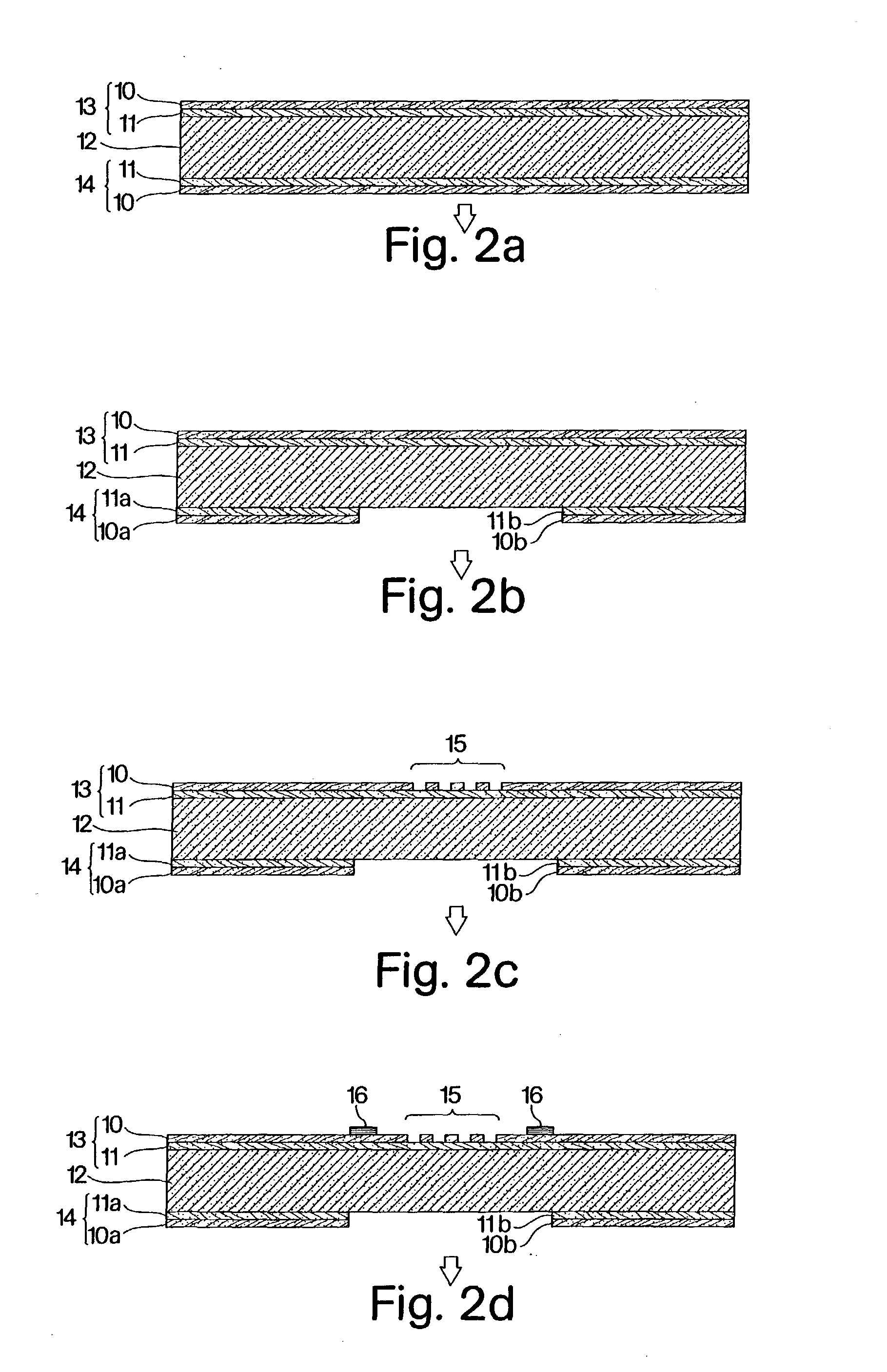Integrated palladium-based micromembranes for hydrogen separation and hydrogenation/dehydrogenation reactions
a technology of hydrogen separation and hydrogenation, applied in the field of separation membranes, can solve the problems of large volumes of stored hydrogen gas, difficult hydrogen storage for portable or mobile power sources, and high cost of hydrogen storag
- Summary
- Abstract
- Description
- Claims
- Application Information
AI Technical Summary
Benefits of technology
Problems solved by technology
Method used
Image
Examples
example 1
[0084] A Micromembrane
[0085] A palladium micromembrane was prepared according to the process shown in FIG. 2. In this example, the membrane included a top support layer of silicon nitride (layer thickness=0.3 .mu.m) positioned adjacent a support layer of silicon oxide (layer thickness=0.2 .mu.m). This process was developed as provided by the MEMS field. A layer of palladium (layer thickness=0.2 .mu.m) was deposited adjacent the silicon oxide layer. The holes were patterned by photolithography and have a diameter of 4 .mu.m and a total width of the device is 700 .mu.m. Only one heater segment is used in this example. The length of one heater segment is about 3.4 mm.
[0086] FIG. 8 shows a photocopy of a photograph displaying a top view of the microfabricated silicon chip incorporating the sub-micron scale membrane. Features of FIG. 8 include composite membrane 114, Pt heater 110 and perforations (holes) in SiO.sub.2 / Si.sub.3N.sub.4 112. The channel in the device is 1.2 cm long, and the...
example 2
[0088] Hydrogen Flux Through the Micromembrane
[0089] FIG. 10 shows a part of a selective flux of hydrogen from a mixture of 90 / 10 N.sub.2 / H.sub.2 at elevated membrane temperatures, using the membrane of Example 1. The devices were fixed onto an aluminum plate and mounted on an XYZ stage which contained the gas manifold and allowed for alignment with the flow card. In this experiment, a gas flow of a 9:1 mixture of nitrogen and hydrogen is contacted on one side of the membrane, and a flow of pure argon is contacted on the opposite side. The flow rates on both sides are about 20 sccm (N.sub.2 118 and H.sub.2 120). The composition of the nitrogen / hydrogen mixture exiting the device is monitored using a quadrupole massspectrometer (QMS). The membrane temperature is measured using the temperature sensing resistor on the membrane, and the membrane is heated resistively using the integrated heater and a power supply. When the membrane temperature is elevated, the exit hydrogen concentratio...
example 3
[0091] Formation of Silicon Wafer
[0092] A silicon wafer is covered with a layer of nitride, to serve as a KOH mask. The nitride on the front and back sides of the wafer is patterned, and the whole wafer is etched with 20% KOH, resulting in a capping structure shown in FIG. 12. The resulting capping wafer possesses about 250 .mu.m deep channels on one side, with an inlet and an outlet port accessing the channel from the top side, and access holes for probes etched all the way through the wafer.
[0093] The capping wafer 136 and the membrane 138 can be bonded together prior to dicing, using an adhesive layer, such as an epoxy. The bond was accomplished using a photoresist stamping method. A thin layer (.about.2 .mu.m) of photoresist was coated onto a dummy wafer. The capping wafer was briefly contacted with the photoresist, and then aligned and pressed together with the membrane wafer. The wafers were baked at 100 .degree. C. for 1 h and then the wafers were diced to release individual ...
PUM
| Property | Measurement | Unit |
|---|---|---|
| Angle | aaaaa | aaaaa |
| Angle | aaaaa | aaaaa |
| Angle | aaaaa | aaaaa |
Abstract
Description
Claims
Application Information
 Login to View More
Login to View More - R&D
- Intellectual Property
- Life Sciences
- Materials
- Tech Scout
- Unparalleled Data Quality
- Higher Quality Content
- 60% Fewer Hallucinations
Browse by: Latest US Patents, China's latest patents, Technical Efficacy Thesaurus, Application Domain, Technology Topic, Popular Technical Reports.
© 2025 PatSnap. All rights reserved.Legal|Privacy policy|Modern Slavery Act Transparency Statement|Sitemap|About US| Contact US: help@patsnap.com



